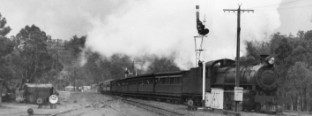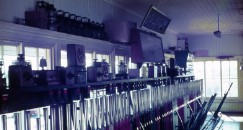Mundaring
MUNDARING | |
WAGR - Eastern Railway (E. R.) | |
1938 WAGR MAP Mileage = 21 | |
Next Down Station: | Next Up Station: |
SAWYERS VALLEY | ZAMIA |
Quick Facts |
|
Station opened: |
Station Closed |
11th July 1898 |
23rd January 1954 |
Mechanical |
Electrical |
6 Levers |
Electric Staff Instruments |
Fate: Only part of the original platform remains |
|
Mundaring has had over its history, two Railway Stations, located quite near each other and were situated high in Western Australia's then heavily timbered Darling Scarp on the orignal section of the Eastern Railway between Bellevue and Lion Mill (later named Mount Helena).
The first Mundaring station, originally named Gugeri was located at the 34 mile. At this time the station had two sidings: Sexton's Siding being 150 feet long; and Holmes & Blain's Siding being 260 feet long.
This first station seemed to have a bit of confusion about the sidings in use there as is evidenced by the following entry in the Weekly Notice 3 of 1897:
GENERAL INSTRUCTIONS.
_____
Mundaring Sidings.
Some confusion exists regarding the Sidings at Mundaring, (late Gugeri). All concerned are hereby informed that wagons should be labelled to MUNDARING, and not to GUGERI’S. There are two Sidings at Mundaring, the one on West side of Station belonging to Holmes and Blain, and the other on the East side to the Adelaide Timber Company. Guards having wagons on their train for Gugeri, should see that they are placed in the proper Sidings. Much inconvenience and delay has recently been caused by wagons for the Adelaide Timber Company being placed in Holmes Blain and Coy’s, Siding. and vice versa.
___
On the 1st of December 1897 Mundaring officially opened as a booking station.
Mundaring's first station was closed on 11th July 1898.
The station shown in this slide show, is the second station to carry the name Mundaring.
The second Mundaring Station was located at a distance of 33 miles 4 chains (measured from Fremantle) opened approximately seven months later. As Weekly Notice No. 28 of 1898 proclaimed:
Mundaring - Opening of New Station.
On and after Monday next, 11th July, the present Mundaring Station will be closed, and the new station situated at Mileage 33 - 4 will be opened.
Trains will not stop at the old Station and passengers should not be booked thereto.
Goods must be consigned to the new Station, and under no circumstances should they be accepted for conveyance to the old Station.
___
On 29th of August 1898 point indicators were provided on the facing points at each end of the crossing loop to indicate to train drivers the setting (or 'lay') of the points before taking their trains into the station.
The train working method over the single line between stations was Electric Staff, the details of which were published in the Appendix to the Working Time table on 1st of February 1901;
Smith's Mill - Mundaring: Shape of Staff Head, Round; Colour of Staff, Red
Mundaring - Lion Mill: Shape of Staff Head, Triangle; Colour of Staff, White
___
1907 saw the installation of signals in conjunction with the connection of the line to the Mundaring Weir. Full details appearing in Weekly Notice 36 of 1907:
Mundaring - Connection with Weir Line - Signals.
On Wednesday, the 4th September, 1907, the following new signals will be brought into use:-
Down Home . - 22 feet high on Down side of line 20 yards outside facing points.
Down Distant . - 40 feet high on Down side of line 616 yards from Home signal.
Up Home . - 22 feet high on Down side of line 20 yards outside facing points.
Up Distant . - 23 feet high on Up side of line 792 yards from Home signal.
Levers are fixed on platform and are interlocked. Facing points are fitted with detectors, and signals can only be lowered for Main Line. The indicators will be removed.
All concerned to note.
___
Three years later, revised signalling was announced in Weekly Notice No 20 of 1910:
Mundaring - Signalling and Interlocking.
On Thursday, May 19, ther following new signals will be brought into use:-
Up Home from undaring Weir line, 22 feet high, on Up side of line, 22 yards from facing points.
Up Distant from Mundaring Weir line, 24 feet high, on Down side of line, 400 yards from Home Signal.
Facing points will be fitted with detector lock, and signals can only be lowered for platform road.
The points leading from platform road to Weir line will be provided with point indicator of new pattern as per Rule 69, Clause C.
___
The completion of the Mundaring Weir saw an increase in eager sightseers all wanting to view this marvel of construction and therefore picnic trains became a booming business for the railways. So much so that special working methods had to be adopted, such as these from the 1922 General Appendix to the Book of Rules and Regulations and the Working Time Table:
Bellevue - Mundaring.
Special Holiday Working to be introduced when authorised by the Chief Traffic Manager.
To facilitate the working of holiday traffic the Electric Train Staff System between Bellevue and Mundaring will, when authorised by the Chief Traffic Manager, be temporarily suspended and the Train Staff and Ticket system substituted, Greenmount and Darlington being opened as temporary Block Telephone stations.
Before any train is permitted to leave Bellevue or Mundaring, the Engine-driver and Guard must be advised in writing of the intermediate Block Stations, and their signatures obtained on a copy.
As there are no fixed signals at either Darlington or Greenmount, engine-drivers must approach same cautious, and must not enter either station, or proceed on the journey, until hand signalled by the signalman to do so. Under no circumstances must Line Clear be given at the intermediate Block Stations for an Up train to approach, until the preceding Up train has departed, and is proceeding on its journey.
Before the Train Staff and Ticket System is installed, the Electric Staff must be conspicuously labelled "Out of Use." The Electric Train Staff must be taken possession of by the Officer authorised to instal the Train Staff and Ticket System, and must be retained by him until the Train Staff is withdrawn and the Electric Train Staff System is again brought into use.
______________________________________________
Mundaring.
This is the Junction Station of the Mundaring Weir Line.
Up Main, Up Branch line, and Down Main line Home and Distant signals are provided at this station. A point indicator of the design illustrated in Rule 70, Clause (c), of the Book of Rules and Regulations is fixed to the crossover points leading from the platform road to the Branch line.
As this station is approached by a steep falling gradient on the Up journey, Engine-drivers and Guards must keep their trains well under control.
Whe two trains approach at or about the same time, precedence must be given to the Down train to avoid, whenerver possible, stopping on the grade.
There is no person in charge of this station at night, and after the Station-master has ceased duty Guards will be held responsible for working the traffic in accordance with the regulations.
___
The end of the era of travelling to the Mundaring Weir by train for so many people was heralded in Weekly Notice No. 44 of 1952when it announced that:
Mundaring Weir line, 02/12/1952 closed to traffic.
___
A similar fate befell the entire branch a few years later when Weekly Notice No 4 of 1954 proclaimed:
Mundaring Branch closure, from 23/1/1954, delete all reference to Mountain Quarries Ltd (Boya), Darling Range Firebrick Co (Glen Forrest), Boya, Darlington, Glen Forrest, Greenmount, Mahogany Creek, Mundaring, Sawyers Valley, Zamia.
___
Today, a visitor to Mundaring can still see the remains of the platform which is now used as a performance stage; a small open air lever frame which is raised up to enable the interlocking mechanism to be viewed, and a signalling sculpture. This last item uses signal posts and parts of signals in an artistic and interpretive theme to tell a story of the station's role in the state's development. Nearby, the orignal Station Master's house is still in place, and fully restored, and is in use by the local Historical Group.
NOTE: This page is under development - please check back later, however, if you have any additional information on this signal cabin, it would be most welcome - please use the e-mail form provided.
Any additional information on this Station Frame would be most welcome - please use the e-mail form provided on this page.
Information researched and interpreted by Chris J E French
This page designed and provided by Chris. J. E. French of SignallingWA
Photographs © by David Beazley and courtesy of RHWA Archives and Diagram of Signalling by WAGRA. G. R.
This page is copyright, and permission must be sought from SignallingWA before this page is used for any purpose other than personal education.
[Buy this page] or [View your SignallingWA ShoppingCart]
MUNDARING Employees | ||
This list may not be complete and does not yet include employees who worked here without being appointed. Where an appointment date is unknown, the Weekly Notice (WN) date advising of the appointment or other official documentation, i.e. Certificate of Competency (CC) will be used. | ||
Name | Appointed | Position |
Is a name missing? Please submit any corrections / additions with suitable evidence using the e-mail form above. | ||


